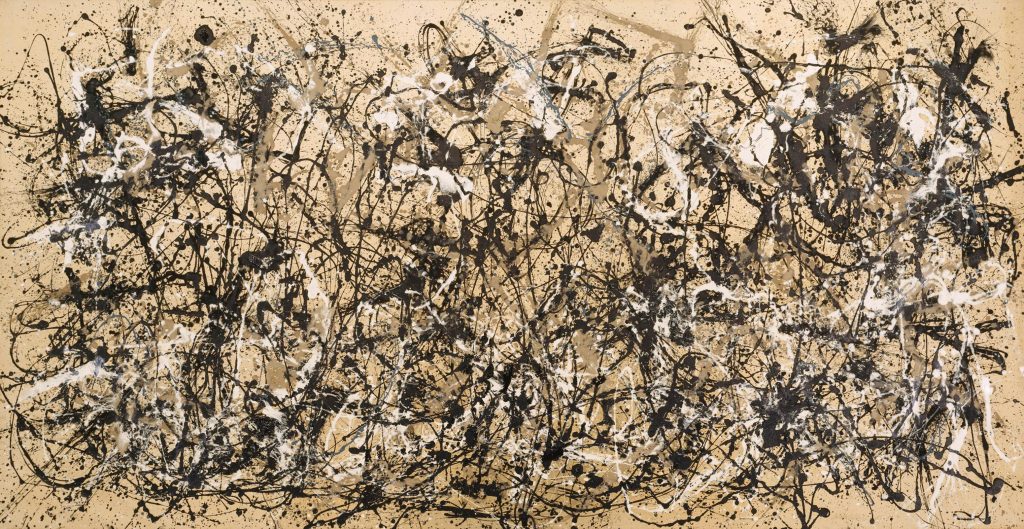Jackson Pollock Autumn Rhythm no 30 1950

Jackson Pollock was the first man to create the drip painting in 1950. Looking at his painting the colours are very plain only using black, white, grey and brown, however these colours contrast with the canvas Pollock did not prime. They stand out more making these colours more vibrant, bold and eye catching. Where as if the background was a solid colour you would lose the abstract line work. Pollocks painting portrays a lot of curvilinear with vast long lines he created by pouring, dripping, splattering paint with sticks, knives and trowels. He achieved these dramatic lines by laying the canvas flat on the floor instead of using a easel.
The form of this artwork is dynamic not one line/splatter is the same, and the idea that there is a constant change in this painting not one bit will match a section of the artwork. It is also very dense and abstract with everything being closely compacted and the idea of it being abstract with the different shapes and textures of paints layed on top of one another, making the artwork unrealistic to the eye. The tonal aspects of this painting include the dramatic marks and the lines he made on his artwork that were impetuous and demonstrated to look like an accident however also show Pollocks control with his technique he used with his paintings.
This piece of artwork is also very chaotic with some of the markings being heavy, light and even some of the paint has been diluted down to build layers. The linear work is very unpredicted some being vertical, horizontal, straight and curved. Back in 1950 a traditional way to paint would be to use paint, canvas and to produce something very realistic, however Pollock wanted to go against the traditional ways using different materials, techniques and producing abnormal paint markings.
Andres Serrano Piss Christ 1987

This piece of artwork depicts a photograph of a small plastic crucifix statue submerged in a bright red/yellow liquid, in which the artists openly admits that it is his own urine that the art has been submerged in. Looking at this piece of artwork there is a massive contrast between this piece and Jackson Pollocks piece. The colours are very bright and bold, also the photograph is very saturated with a variation between different tones of red, orange and yellow. The tone is very light around the crucifix however if you look at the corners of the art work the tone is a lot darker, the artist has done this to draw the viewers attention to the crucifix. When looking at this photograph the texture does not seem smooth due to the air bubbles in the tank. The photograph is 60 by 40 inch Cibachrome print.
The photograph was one of a series of photographs that Serrano had made that involved classical statues which had been submerged in various liquids, for example other liquids Serrano uses apart from urine involve blood, milk and semen. His art work is very unique and strange due to the unusual materials he uses. Serrano’s photograph of the Piss Christ symbolizes the way Christ died and the idea that not only did blood poured out of him however other liquids did, such as faeces and urine. He believes that the idea of using urine within the photograph of Christ on a crucifix is bringing the symbol closer to its original meaning, the idea that Christ probably did see urine and faeces come out of him when he was tortured and left to die on the crucifix.
This piece of art work did cause a lot of controversy, some people thought it was disrespectful to use urine to submerge the photograph in to. The art work was not intended to cause a political statement on religion, however it did cause a lot of commotion. Serrano’s photographs featuring religion are heavily influenced by baroque paintings. Piss Christ is considered to be the most controversial artworks of the 20th century.